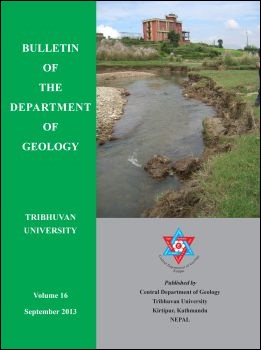Toppling and wedge failures in Malekhu River area, Malekhu, Central Nepal Lesser Himalaya
DOI:
https://doi.org/10.3126/bdg.v16i0.8881Keywords:
Landslide, wedge failure, toppling, Malekhu River, Central Nepal Lesser HimalayaAbstract
A huge landslide was identified on the right bank of the Malekhu River at about 1 km upstream from the Malekhu Bridge of the Prithvi Highway, and was named Malekhu Landslide. The landslide area consists of quartzite with sericite partings, chlorite schist and amphibolite of the Robang Formation of the Kathmandu Complex. The landslide extends for about 200 m along the river bank slope and its crown and toe have elevation respectively of 429 m and 361 m a.s.l. The major portion of the hillslope has been altered by landsliding as evidenced from the different geometry of slopes consisting of very steep scarp slope, steep to moderate slope with toppled and wedge failure debris, and several wedges and gullies. The right-side up layers have an average dip direction of 167° and a plunge of 56-90°, whereas the overturned layers have an average dip direction and plunge of 316°/32°. The direction towards which the toppling had occurred is 167°. The overturned layers had rotated to 36°, during which the layer dip direction had rotated counterclockwise to an amount of 31° from the major direction of toppling, and this rotation should have occurred during sliding of the toppled block. The Malekhu Landslide is a complex landslide experiencing more than one mode of failure of which the most prominent one is the toppling. It is a kind of flexural toppling of passive mode and had already occurred and now is suspended. The second mode of failure is the wedge sliding. The kinematic analysis of discontinuities on the slope for evaluating possibility of landsliding has indicated that the wedge failure is potential due to the presence of a line of intersection produced by the discontinuity parallel to the foliation of the right-side up layers and the overturned layers. This suggests that the toppled blocks may further slide. It is required to protect the slope from landsliding as there have been extended two unpaved roads one along the crown and the other along the toe of the landslide, and due to existence of the Malekhu Bridge in the downstream stretch of the river.
DOI: http://dx.doi.org/10.3126/bdg.v16i0.8881
Bulletin of the Department of Geology Vol. 16, 2013, pp. 21-28
Downloads
Downloads
Published
How to Cite
Issue
Section
License
© Central Department of Geology, Tribhuvan University, Nepal

